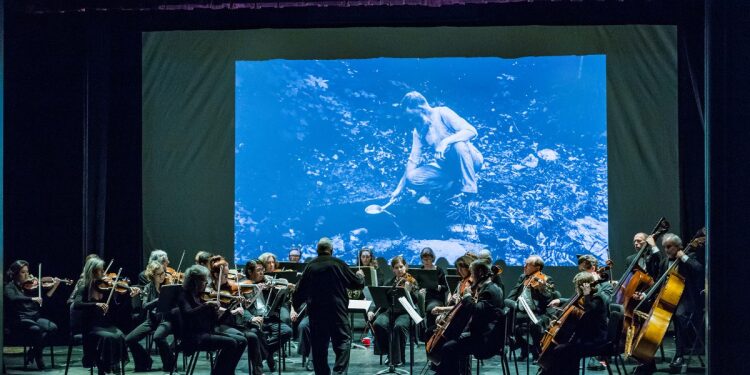On August 27, 2021, as part of the Middlebury New Filmmakers Festival (MNFF), a VSO ensemble played an arrangement of the film score to the animated short film Two Balloons live. This was followed by a panel discussion featuring Peter Broderick, music composer, Matt LaRocca, music arranger, the musicians, and film festival staff.
This is the fourth year that the VSO has collaborated with the MNFF to award a VSO prize, which is given to the short film whose filmmaker makes the best use of music to underscore the story or message of their work. This year’s VSO Award went to Mate, an animated short by Rusty Eveland, to be premiered in 2022.
Matt LaRocca, Artistic Advisor and Project Conductor at the VSO, answered a few questions about the relationship between music and film.
What is the VSO Award and why is it unique?
The VSO and MNFF grant an award to a short film that makes the best use of music to underscore the story and message of their work. A panel of musicians and staff from the VSO watch a number of short films, looking for the one in which the music pairs perfectly with the visuals to elevate the end result. It’s not necessarily about the best film, or even the best music; we’re looking for that unique combination of auditory and visual elements that work together perfectly.
How do you work with the composer?
I worked with composer Peter Broderick to imagine how to translate the music he composed for the film to a small chamber ensemble and then, eventually, to a full orchestra. With a live orchestra, one of the things we talked through was how to deal with the foley (or the reproduction of everyday sound effects) that are present in the film version that was released. The whistles of tea kettles, the creak of a door, thunder, gusts of wind and more. In this arrangement, I account for these sound effects through musical painting and extended techniques for the instruments.
Why do you enjoy being a part of this work?
The pairing of live music with film is such a great experience for both the performers and the audience. I get to dig deep into a compelling piece of music as I work on adapting it to a live orchestra, and it’s a joy to be able to work with visuals in real time. From the audience perspective, it’s a truly unique way to experience a film. The music takes on a new meaning and a new relationship with the visuals that is different from a recorded film score.
What is the power of music in film?
Music in film creates a truly transcendental experience. It can shape the emotional response of the viewer and add another dimension to what we’re seeing on the screen. It’s absolutely crucial to the overall experience, and in many ways can be one of the biggest things we take away. Personally, music helps create a direct link in my memory to a great film. Just a few notes of any number of iconic film scores triggers a rush of images, emotions, and memories. The otherworldly nature of Tan Dun’s Crouching Tiger, Hidden Dragon, the horror and anxiety of Johnny Greenwood’s There Will Be Blood, or the quirkiness of any number of Danny Elfman films. Some are even so powerful they’re inextricably linked to the movie. It’s almost impossible for me to picture Darth Vader without hearing his theme in my head! The connection that is created from how the music and film work together is incredibly powerful and wonderfully unique.


